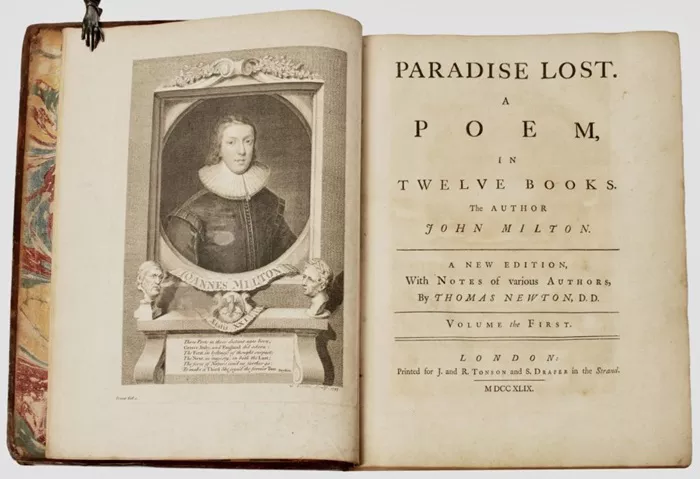Welcome to Poem of the Day – On the Same Poem by John Milton.
John Milton, an influential poet and thinker of the English Renaissance, is best known for his epic works such as Paradise Lost. However, his lesser-known poems also hold significant value and offer unique perspectives on human experiences, politics, and spirituality. One such poem, On the Same Poem, presents an opportunity for deeper reflection on Milton’s style and ideas. This article delves into the meaning and elements of On the Same Poem, offering a comprehensive explanation that highlights its thematic concerns and literary techniques.
On the Same Poem
I did but prompt the age to quit their clogs
By the known rules of ancient liberty,
When straight a barbarous noise environs me
Of owls and cuckoos, asses, apes, and dogs;
As when those hinds that were transformed to frogs
Railed at Latona’s twin-born progeny,
Which after held the Sun and Moon in fee.
But this is got by casting pearl to hogs,
That bawl for freedom in their senseless mood,
And still revolt when Truth would set them free.
Licence they mean when they cry Liberty;
For who loves that must first be wise and good:
But from that mark how far they rove we see,
For all this waste of wealth and loss of blood.
On the Same Poem Explanation
Background of the Poem
On the Same Poem is a poem written by Milton in the 17th century. It is not as widely read as some of his more famous works, but it still carries a heavy weight in terms of its philosophical and literary contributions. The poem was likely composed in response to criticisms of his earlier works, particularly regarding the themes and techniques he employed.
Milton was a highly intellectual figure, often engaging with the political and religious debates of his time. He faced much opposition, especially for his stance on issues like the freedom of the press and the role of government. On the Same Poem reflects his ability to respond to critics, using his poetic craft as both a shield and a means of self-expression.
Theme and Message
The central theme of On the Same Poem revolves around the idea of poetic immortality. Milton, through his verse, asserts the lasting power of poetry to transcend time and continue to speak to future generations. In the poem, he seems to address the notion that a poem, once written, holds an enduring significance, irrespective of the passing of time or changes in society.
Another theme that emerges is the tension between public opinion and personal conviction. Milton’s response to critics indicates a strong belief in the validity of his own artistic vision. He is unafraid of pushing boundaries in order to maintain his creative integrity. The poem is a reminder of the power of art to communicate deep truths, even when misunderstood by its immediate audience.
Structure and Form
Milton’s choice of structure in On the Same Poem follows the traditional form of 17th-century English poetry. He uses blank verse, a form of unrhymed iambic pentameter, which was commonly used in his time. This form allows Milton to explore his ideas more freely and gives the poem a solemn, elevated tone.
The poem is composed of several stanzas, each focusing on different aspects of poetry and its value. The language Milton uses is rich with classical references and rhetorical devices, which enhances the poem’s philosophical undertones. The seamless flow of ideas and the controlled rhythm of the verse reflect Milton’s mastery of form.
Literary Devices
Milton employs various literary devices throughout On the Same Poem, all of which contribute to its emotional and intellectual depth. Some key devices include:
Allusion: Milton frequently refers to classical mythology, historical events, and biblical stories, which serve to enrich the poem’s meaning. These allusions draw connections between the poet’s ideas and the greater historical and literary tradition.
Metaphor: Milton uses metaphors to express complex concepts. For example, he compares poetry to a powerful, immortal force, implying its ability to outlive both the poet and the social context in which it was created.
Irony: In some parts of the poem, Milton employs irony to highlight the discrepancy between the way his work is perceived and its true value. The criticism he faces is juxtaposed with the timeless relevance of his poetry.
Hyperbole: To emphasize the grandeur and significance of poetry, Milton exaggerates its effects, portraying it as something that can reach across generations and transcend the physical world.
Interpretation
The poem’s ultimate message is one of self-assurance and pride in the art of poetry. Milton defends his work not only as a form of personal expression but as an art form that carries a higher truth. The poem suggests that while critics may misunderstand or misjudge a poet’s intentions, the true power of poetry lies in its enduring legacy. In this sense, Milton also speaks to the idea of artistic freedom—the freedom to create according to one’s vision, regardless of public approval.
Milton’s work also encourages a reflection on the ephemeral nature of human life. While people, ideas, and political regimes may fade, art remains as a testament to humanity’s thoughts, struggles, and triumphs. This offers a sense of comfort to the poet and to those who engage with the poem long after the poet’s death.
Conclusion
On the Same Poem by John Milton is a reflection on the enduring power of poetry. In this poem, Milton defends the artistic value of his work, asserting that poetry transcends both time and criticism. Through rich metaphors and classical allusions, Milton reminds readers of the lasting impact that art can have, and of the importance of staying true to one’s creative vision. The poem speaks to anyone who has ever felt misunderstood or challenged, reinforcing the idea that the value of art is not determined by immediate reactions but by its eternal resonance. Milton’s message is clear: poetry, in its purest form, is immortal.

